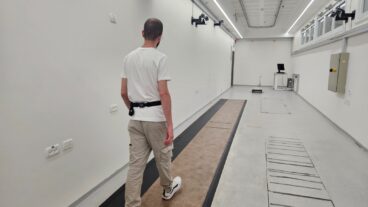GVT’s technology inserts a healthy gene into cells where genes are malfunctioning in treating cancers.Gene Vector Technologies is one of the few gene therapy companies in Israel. Little gene therapy research is conducted in Israel either, and commercial applications are still virtually nonexistent.
Gene therapy is different from regular drug therapies in that it works by inserting a gene into the body, rather than by altering a gene’s function. Gene therapy tries to insert a healthy gene into a cell that lacks one, or is dysfunctional. Sometimes a gene is inserted in a cell where it never existed in nature.
“The principle of gene therapy is to insert the gene into the cell nucleus to instruct the production of the protein we want to be expressed in that cell,” said GVT chief executive Ehud Yosha. Current gene therapy research is focusing on treating certain types of cancers and hereditary diseases, including hemophilia, thalassemia, a form of anemia, and liver diseases.
There are several serious problems with gene therapy that are delaying its widespread use. Yosha said the greatest hurdle is selecting a suitable vector, the corpuscle on which the gene will ride into the body. No completely suitable vehicle has yet been found. “Vectors used until now have had two main hurdles. One is the efficacy of the insertion. The gene cannot always be inserted into the body in a way that allows it to function long enough to effect a cure.”
The second hurdle is safety. This is a major issue. The death of a patient in September 1999 from a gene therapy treatment has delayed and deterred clinical trials. The patient was participating in a clinical trial to treat a rare liver disease at the Institute for Human Gene Therapy at the University of Pennsylvania. In that case, the vector used to insert the gene was a virus containing DNA.
“The body’s immune system aggressively fights the virus. That was not anticipated. (The patient) died from immune rejection,” Yosha said.
Under these circumstances, researchers have no control over events. Various genetic changes can occur in the vector, and doctors don’t know precisely what they’re injecting into the patient.
“There are also liposome-based vectors (liposomes are the fatty structures that sheath DNA), or direct micro-injection of DNA into the cell. While safe to use, these methods are frequently insufficiently effective, because the body breaks down micro-injected DNA.”
GVT is offering a solution to the problem of gene therapy vector maintenance. The company is developing a technology utilizing the viral vector SV-40 and its preparation in a test tube from controlled composites, yielding a pseudo-virus for use as a vector for gene therapy. The procedure that is carried out in the test tube is more efficient and controlled than if it were carried out in a cell culture.
“We are developing a simple protein that contains only the gene we wish to insert. There is no viral DNA or genetic changes in the viruses, because there is simply no viral DNA,” Yosha said.
The vector is very effective for a great number of target cells, including those for which most vectors are ineffective, such as hemoglobin inside bone marrow. The vector can also be inserted into liver, muscle and nerve cells.”
Yosha said that safety levels are high. Production is carried out entirely in test tubes, which allows for controlled manufacturing. “No other company in the world uses this production method with such a high degree of safety and efficiency.”
If successful, the platform could be used to treat several diseases. At the moment, GVT is focusing on oncology, specifically solid tumor-type cancers amenable to gene therapy, such as breast cancer. Non-solid tumor cancers such as leukemia and lymphoma are not candidates for these treatments.
How does gene therapy work against cancer? Let us begin with the problem: Cancer patients treated with chemotherapy suffer from a severe decline in their white blood-cell count, damaging the immune system, and resulting in even more fragile and susceptible health.
GVT’s gene therapy inserts the gene into white blood cells to induce them to produce a chemical in their membranes that enhances the immune system.
“This allows patients to absorb heavier doses of chemotherapy, without risking their lives,” Yosha said.
GVT is now working on this treatment, and hopes to develop other applications later, including treatments for diseases of the liver and the cardiovascular and central nervous systems.
GVT was founded by two professors at the Hadassah Medical Organization and Hebrew University and Hadassah Hospital, Ein Kerem, Jerusalem and began operating independently a year ago. The company’s labs are based at Hadassah Hospital. The company has six employees based at the Ashkelon Technology Incubator. Other work is conducted in Jerusalem. Yosha previously worked at a private bio-agricultural company before transferring to communications, business development and marketing.
After a standard investment by Israel’s Office of the Chief Scientist, GVT is now seeking financial capital. The company needs $1 million to develop and consolidate its technology.
“Negotiations are underway with private groups. We may very well approach venture capital funds in the near future. It is not a matter of principle. We were simply approached by some private concerns, and thought to exploit this channel as much as possible, and approach venture capital funds afterwards,” Yosha said. “Later, we’ll want to approach a pharmaceutical or biotechnology company that would be interested in the technology, but not at this stage. It is too early now, both in terms of the technology and finances. We want to approach companies when we have a higher valuation.”
Yosha estimates the company still has more than two years at the incubator.
“We are now establishing a science board that will evaluate strategic directions, and will be in contact with biotechnology companies for the purpose of research cooperation,” he said. “The aim is that will ripen into business cooperation at some point.”












